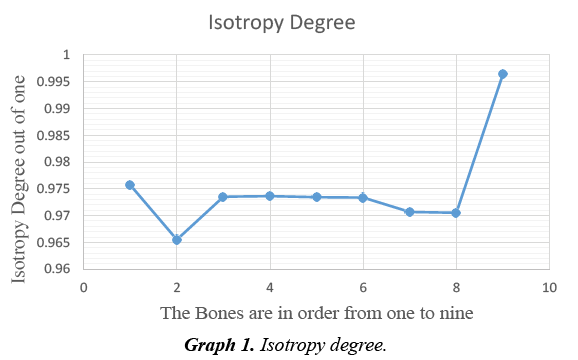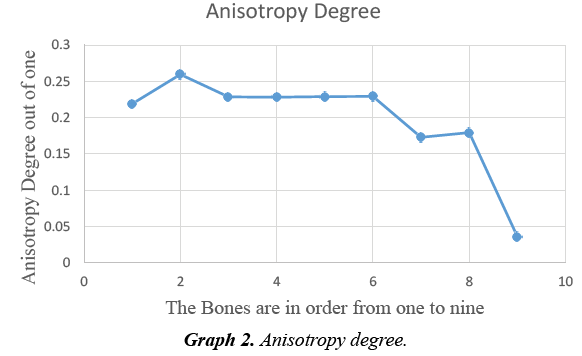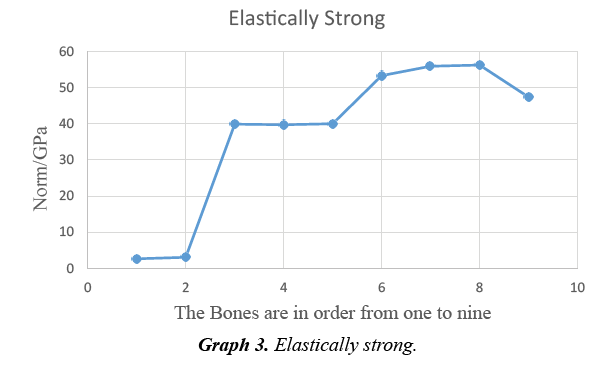Short Communication - Materials Science and Nanotechnology (2018) Volume 2, Issue 1
Some properties of bones at different nanostructural microstrucral and mesostructural levels.
Fae`q AA Radwan*Faculty of Engineering, Near East University, Turkey
- Corresponding Author:
- Fae`q AA Radwan
Faculty of Engineering, Near East University
Turkey
E-mail: faeq.radwan@neu.edu.tr
Accepted date: March 14, 2018
Citation: Radwan FAA. Some properties of bones at different nanostructural microstrucral and mesostructural levels. Mater Sci Nanotechnol. 2018;2(1):13-14.
DOI: 10.35841/nanotechnology.2.1.13-14
Visit for more related articles at Materials Science and NanotechnologyAbstract
The norm of elastic constant tensor and the norms of the irreducible parts of the elastic constants of bones at different nanostructural, microstrucral and mesostructural levels are calculated. The relation of the scalar parts norm and the other parts norms and the anisotropy of bones at different nanostructural, microstrucral and mesostructural levels are presented. The norm ratios are used to study anisotropy of bones at different nanostructural, microstrucral and mesostructural levels and the relationship of their structural properties and other properties with their anisotropy are given.
Keywords
Mineralized collagen, Microfibril, Fibril, Fiber, Lamella, Canaliculi, Lacunae, Osteous, Cortical bone Nanostructrctural level, Nanostructrctural level, Mesostructural level, Norm, Anisotropy, Elastic constants.
Introduction
The decomposition procedure and the decomposition (Elastic constant tensor can be decomposed into two scalar parts, two deviator parts and one nonor part) of elastic constant tensor is given [1,2] also the definition of norm concept and the norm ratios and the relationship between the anisotropy and the norm ratios are given [1,2]. As the ratio (Norm of the scalar part of the elastic constant tensor/Norm of the elastic constant tensor) becomes close to one the material becomes more isotropic, and as the ratio (Norm of the nonor part of the elastic constant tensor/Norm of the elastic constant tensor) becomes close to one the material becomes more anisotropic is explained [1,2].
Calculations
By using and the decomposition of the elastic constant tensor, we have calculated the norms and the norm ratios as shown in Tables 1 and 2.
| Bone | c11 | c22 | c33 | c12 | c13 | c23 | c44 | c55 | c66 |
|---|---|---|---|---|---|---|---|---|---|
| Mineralized collagen, microfibril, Nanostructrctural level | 1.07 | 1.07 | 1.07 | 0.434 | 0.434 | 0.434 | 0.632 | 0.632 | 0.632 |
| Mineralized collagen, fibril, Nanostructrctural level | 1.133 | 1.185 | 1.226 | 0.468 | 0.468 | 0.474 | 0.787 | 0.787 | 0.787 |
| Mineralized collagen, fiber, Nanostructrctural level | 16.144 | 16.144 | 16.11 | 6.233 | 6.233 | 6.237 | 9.928 | 9.928 | 9.928 |
| Lamella, microstrucral level | 16.08 | 16.08 | 16.07 | 6.21 | 6.21 | 6.22 | 9.88 | 9.88 | 9.88 |
| Lamellae with canaliculi, microstrucral level | 16.18 | 16.18 | 16.14 | 6.24 | 6.24 | 6.25 | 9.96 | 9.96 | 9.96 |
| LRC Lamellae, microstrucral level | 21.57 | 21.57 | 21.51 | 8.32 | 8.32 | 8.33 | 13.28 | 13.28 | 13.3 |
| Lamellae with lacunae, microstrucral level | 19.44 | 20.34 | 32.2 | 8.24 | 8.25 | 8.25 | 14.02 | 12.33 | 12.54 |
| Osteous, mesostructural level | 19.44 | 20.34 | 32.3 | 8.24 | 8.25 | 8.25 | 13.17 | 13.16 | 13.18 |
| Cortical bone, mesostructural level | 21.96 | 23 | 26.04 | 8.24 | 10.19 | 8.25 | 6.89 | 6.12 | 6.45 |
Table 1: Elastic constants (GPa) [3].
| Bone | Ns | Nd | Nn | N | NS/N | Nd/N | Nn/N |
|---|---|---|---|---|---|---|---|
| Mineralized collagen, microfibril, Nanostructrctural level | 2.56451 | 0 | 0.57557 | 2.62830 | 0.97573 | 0 | 0.21899 |
| Mineralized collagen, fibril, Nanostructrctural level | 2.94165 | 0.06102 | 0.79082 | 3.04671 | 0.96552 | 0.02003 | 0.25956 |
| Mineralized collagen, fiber, Nanostructrctural level | 38.8703 | 0.02427 | 9.12636 | 39.9273 | 0.97353 | 0.00061 | 0.22857 |
| Lamella, microstrucral level | 38.7178 | 0.01024 | 9.07045 | 39.7661 | 0.97364 | 0.00026 | 0.22810 |
| Lamellae with canaliculi, microstrucral level | 38.9629 | 0.02862 | 9.16211 | 40.0257 | 0.97345 | 0.00072 | 0.22891 |
| LRC Lamellae, microstrucral level | 51.9518 | 0.05348 | 12.2324 | 53.3725 | 0.97338 | 0.00100 | 0.22919 |
| Lamellae with lacunae, microstrucral level | 54.3382 | 9.34852 | 9.67607 | 55.9791 | 0.97069 | 0.167 | 0.17285 |
| Osteous, mesostructural level | 54.65294 | 9.05628 | 10.10629 | 56.31249 | 0.97053 | 0.16082 | 0.17947 |
| Cortical bone, mesostructural level | 47.26546 | 3.61626 | 1.72146 | 47.43485 | 0.99643 | 0.07624 | 0.03629 |
Table 2: The norms and norm ratios.
Results and Conclusion
From Table 2 and the Graphs 1-3 and analysing the ratio 
we can conclude that Cortical bone, mesostructural level is the most isotropic bone which has the largest value (0.99643) and
has the smallest value of  , (0.03629) and small value of
, (0.03629) and small value of  , (0.07624) and Mineralized collagen, fibril, Nanostructrctural
level is the least isotropic bone which has the smallest value
(0.96552) of
, (0.07624) and Mineralized collagen, fibril, Nanostructrctural
level is the least isotropic bone which has the smallest value
(0.96552) of  and has the largest value (0.25956) of
and has the largest value (0.25956) of  and has large value (0.02003) of
and has large value (0.02003) of  , so we can say that Mineralized collagen, fibril, Nanostructrctural level is the most
anisotropic bone. Also we can make the comparison in the same
structural level, in the case of Nanostructrctural level the most
isotropic bone is Mineralized collagen, microfibril, and the most
anisotropic bone is Mineralized collagen, fibril, and in the case
of microstrucral level, the most isotropic bone is Lamella, and
Lamellae with lacunae is the most anisotropic bone, and in the
case of mesostructural level the most isotropic bone is Cortical
bone and the most anisotropic bone is Osteous.
, so we can say that Mineralized collagen, fibril, Nanostructrctural level is the most
anisotropic bone. Also we can make the comparison in the same
structural level, in the case of Nanostructrctural level the most
isotropic bone is Mineralized collagen, microfibril, and the most
anisotropic bone is Mineralized collagen, fibril, and in the case
of microstrucral level, the most isotropic bone is Lamella, and
Lamellae with lacunae is the most anisotropic bone, and in the
case of mesostructural level the most isotropic bone is Cortical
bone and the most anisotropic bone is Osteous.
Also we can notice by considering the value of N that this value is the highest (56.31249) in the case of Osteous, mesostructural level so we can say that Osteous, mesostructural level elastically is the strongest bone, and the in the case Mineralized collagen, microfibril, Nanostructrctural level (2.62830) which is its value of N is the smallest so we can say that Mineralized collagen, microfibril, Nanostructrctural level elastically is the least strong bone among the bones in the table.
References
- Radwan FAA. Norm ratios and anisotropy degree. J Appl Sci. 2001;1(3):301-4.
- Radwan FAA. Irreducible parts of elastic compliance tensor and anisotropy. J Appl Sci. 2001;1(3):270-4.
- Barkaoui A, Chamekh A, Tarek M, et al. Multiscale approach including microfibril scale to assess elastic constants of cortical bone based on neural network computation and homogenization method. Int J Numer Meth Biomed Eng. 2013;30:318-38.


